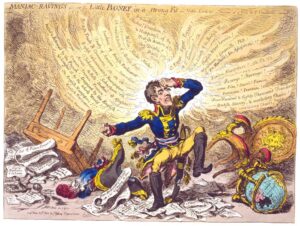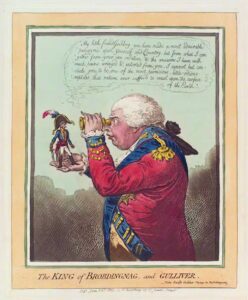This 200-year lie about Napoleon’s height can help you kill your competition.
Unlike Napoleon, I’ll keep this short.
Yes, you read that correctly. “Unlike Napoleon”.
Because despite what you’ve heard, especially given the prominence of the somewhat un-PC term “Napoleon Syndrome” (referring to those who overcompensate in dominance to make up for perceived vertical shortcomings) …Napoleon was NOT short.
You see, while Napoleon’s height of five foot two inches (1.6m) would be perceived as rather short by today’s standards, back in the very early 1800s, the average male height was 1.63m. Rendering Napoleon’s Hobbit-esque insults unfounded.
And yet more than two hundred years on, the myth is as strong today as it was back then.
Why?
Propaganda.

‘Little Boney’ throwing a tantrum
More specifically, propaganda created by a Brit called James Gillray – often called “the father of the political cartoon”.
To add insult to the nation’s ‘scarlet fever’ riddled injury, Napoleon readied 170,000 troops and declared war on Britain.
But, in the face of this impending force, Britons didn’t fear Napoleon thanks to Gillray’s satirical illustrations and caricatures that rendered ‘Little Boney’ as, amongst others, a tantrum-prone toddler, an earthworm, earwig, a feeble spider, and tiny characters from Gulliver’s Travels.

The King… and Gulliver
Gillray’s strategic thinking, and incredible creative talents, were so powerful in blighting Bonepart’s reputation, that Napoleon himself is said to have considered James Gillray’s illustrations did him “more damage than a dozen British generals“.
From Prime Ministers to feared royalty, Gillray used his wit and humour to widely discredit as well as educate through entertainment.
And isn’t that what marketing is? To discredit our competitors in our prospects’ minds (indirectly, fairly, and with dignity of course) so they choose us.
A client of mine doesn’t price match their competitors. And never will. As is their commitment to this policy, I recently developed a creative proposition, internal campaign, training materials and battle cards that discredit the competition’s offering. Not through any creative embellishments or caricatures I might add.
The competition falls short everywhere. Therefore, creatively highlighting their shortcomings to the sales teams, shoots down any cost-based objections and price match requests. All with the help of a rather clever creative proposition… that some might incorrectly call propaganda.
Through wartimes and violent revolutions, the term ‘propaganda’ is often perceived as negative and underhand.
But it’s not.
Again, much like Napoleon’s height, the negativity around the word ‘propaganda’ is a myth.
The very word propaganda (from Latin) means ‘to spread’ or ‘to propagate’. Originally derived from the Catholic church’s Congregatio de Propaganda Fide – which literally translates to the ‘Congregation for Propagating the Faith’.
And again, what is marketing if not communicating to build and reinforce faith and trust in a brand, service or product so strongly it influences audiences to act and buy?
Building ‘faith’ through ‘propaganda’, and taking a leaf out of Gillray’s book by using strategic thinking and carefully considered creativity, is precisely how marketers can not only entertain to educate, and influence audiences far more effectively… but kill the competition too.
Oh, and if you do need strategic creative to help bust your audience’s preconceived myths about ‘the enemy’, let’s chat.
Baz Richardson is the Founder & Creative Director of
Bravo Creative
